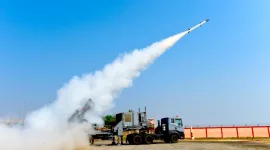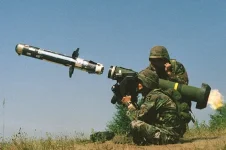- Views: 32
- Replies: 1
New images and footage from Russia, emerging in early November 2025, have provided the first-ever public view of the Sukhoi Su-57 "Felon" stealth fighter with its internal weapons bays open and armed.
The demonstration, which comes just ahead of the Dubai Airshow 2025, is seen as a significant signal of the program's increasing operational maturity and Russia's readiness to actively market the jet for export.
The new visuals clearly show the aircraft configured for a high-risk mission: the Suppression of Enemy Air Defences (SEAD). This specialized role involves hunting and destroying an adversary's radar installations and surface-to-air missile (SAM) batteries to clear a safe path for other friendly aircraft.
A New Glimpse into Stealth Strike Capability
The images reveal the Su-57's central internal bays carrying two Kh-58UShKE anti-radiation missiles. This specific variant is a key piece of the puzzle, as its "KE" designation indicates it has been modified with folding fins, allowing it to fit inside the compact bay of a stealth fighter.The Kh-58 is a high-speed (reportedly Mach 3.6) missile designed to home in on enemy radar emissions from a significant standoff distance of over 200 kilometres.
Alongside the internal anti-radar weapons, the aircraft was shown carrying short-range R-74M2 air-to-air missiles on external hardpoints. This loadout highlights a flexible combat configuration, enabling the Su-57 to defend itself against enemy fighters while its primary mission remains the destruction of ground-based air defences.
While Russia has previously shown the Su-57 firing missiles, this is the first time its internal bays—crucial for maintaining a low radar cross-section (RCS)—have been publicly displayed fully loaded for a specific combat role.
This development suggests growing confidence in the "Felon" as a mature, multi-role stealth platform, moving it beyond the prototype and testing phase.
The Strategic Challenge for India
This enhanced SEAD capability is of particular interest to New Delhi. The Indian Air Force (IAF) faces one of the most formidable air defence environments in the world along its northern and eastern borders.Potential adversaries have established a dense, integrated network built around advanced SAM systems. This includes:
- China's S-400: Multiple squadrons of the advanced Russian-made S-400 system, which China was the first export customer to receive.
- China's HQ-9: A highly capable, long-range indigenous SAM system, reportedly a "hybrid" design based on Russia's S-300. Open-source reports have confirmed the deployment of HQ-9 systems in regions such as Hotan in Xinjiang, near the Line of Actual Control (LAC) with India.
India's Current SEAD and Future Options
Currently, the IAF entrusts the vital SEAD mission to its 4.5-generation workhorses, primarily the Sukhoi Su-30MKI and Dassault Mirage-2000. These jets are being armed with India's own developing family of anti-radiation missiles.The indigenous Rudram missile program, led by the DRDO, is making significant progress. Rudram-1 has already been tested, and the more advanced, solid-propelled Rudram-II was successfully flight-tested from a Su-30MKI in May 2024.
However, these 4th-generation platforms lack the stealth required to penetrate a mature air defence network protected by systems like the S-400. This is where the Su-57, at least in theory, presents an intriguing option.
A stealth fighter armed with long-range anti-radiation missiles could potentially fill a critical gap, giving the IAF a "first-in" strike capability to dismantle enemy defences.
Hurdles to a Su-57 Acquisition
Despite its apparent suitability for the role, an Indian purchase of the Su-57 faces formidable obstacles that make it an unlikely short-term solution.- Indigenous Priority (AMCA): India's primary focus is now firmly on its own fifth-generation stealth fighter, the Advanced Medium Combat Aircraft (AMCA). The project received formal approval from the Cabinet Committee on Security and is progressing, with Defence Minister Rajnath Singh recently confirming the design phase is complete. The first prototype is expected by 2028, with induction planned for the next decade.
- Production and Reliability: The Su-57 program has been marked by significant delays and very low production numbers. Even the Russian Aerospace Forces operate only a small number of serial-production aircraft as of late 2025.
- Sanctions and Logistics: Strict Western sanctions on Russia's defence industry would create severe challenges for India in securing a reliable supply chain for spare parts, components, and long-term maintenance.
- Integration Costs: The IAF would require any new platform to integrate with its existing and future network of Indian-made weapons, such as the Rudram and Astra missiles. This integration process would be complex, costly, and time-consuming.
The IAF seems committed to the long-term, sovereign path of developing its own indigenous stealth and SEAD capabilities, rather than relying on a costly foreign import with significant geopolitical and logistical uncertainties.
The new images will undoubtedly spark debate, but for now, India's answer to enemy air defences lies with the continued development of its Rudram missile family and the ultimate success of its own AMCA stealth fighter program.





